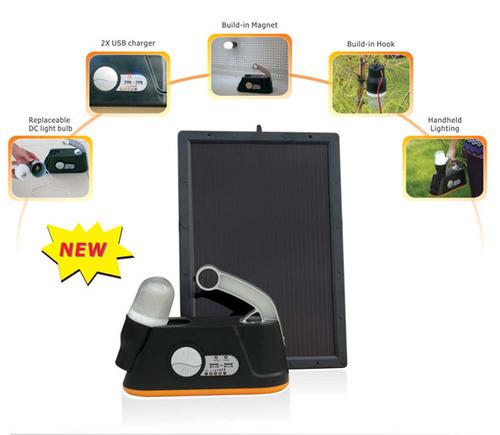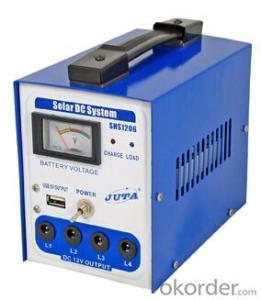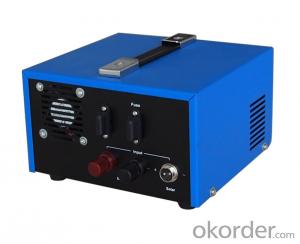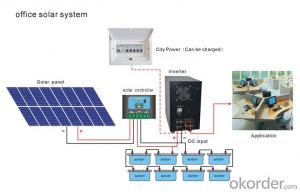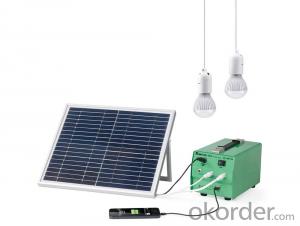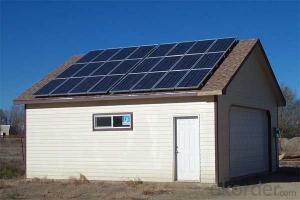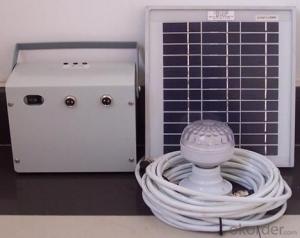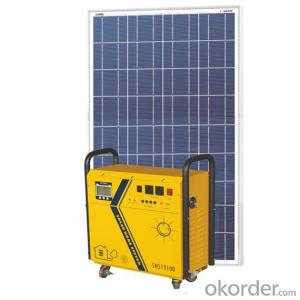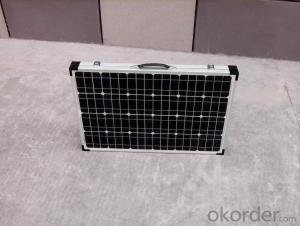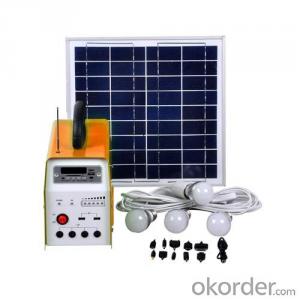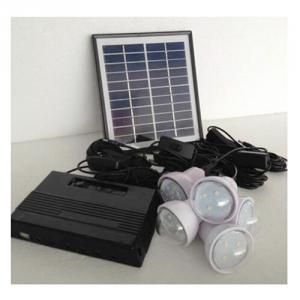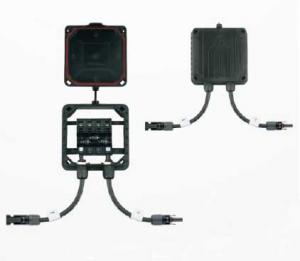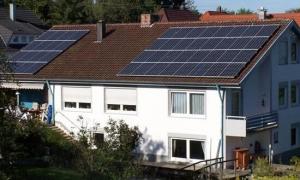Solar Energy Systems Nappanee - Solar Portable Power Kit 6W (TPS-201)
- Loading Port:
- China Main Port
- Payment Terms:
- TT or LC
- Min Order Qty:
- -
- Supply Capability:
- 50000sets m.t./month
OKorder Service Pledge
OKorder Financial Service
You Might Also Like
Product DescriptionDescription: TPS-201 6W Solar Portable Power Kit 1.Solar portable lighting kit for both indoor and outdoor use. Good for sheds, garage, camping 2.Replaceable energy saving/LED bulb provide bright lighting 3.Built-in magnet & hanging hook enables easy fixing of the bulb 4.USB output available to power mobile phones & other electronic devices alike 5.User friendly indicator for easy monitoring of the battery status. 6. 6W Amorphous solar panel + 12V/4.5AH Battery + one pcs 5W lighting with 3M cables + 2 pcs USB output (charging mobile phone) + Voltage indicater |
- Q: How do solar energy systems handle excess power generation?
- Solar energy systems handle excess power generation in a few different ways. One common method is through net metering, where any excess electricity produced by the solar panels is sent back to the grid and the homeowner or business owner receives credits for that excess power. Another approach is to store the excess energy in batteries, which can then be used during times when the solar panels are not generating enough power, such as at night. Additionally, some solar energy systems are designed to automatically adjust the tilt or orientation of the panels to reduce power generation when it exceeds the demand.
- Q: Can solar energy systems be used for powering military bases?
- Yes, solar energy systems can be used for powering military bases. In fact, many military bases around the world are increasingly adopting solar energy systems as a reliable and sustainable source of power. Solar energy systems help reduce dependence on traditional energy sources, enhance energy security, and lower operational costs for military installations. Additionally, solar power offers flexibility and resilience, enabling military bases to maintain critical operations even during grid disruptions or in remote locations where traditional power infrastructure is limited.
- Q: How do solar energy systems contribute to reducing the need for new power plant construction?
- Solar energy systems contribute to reducing the need for new power plant construction by generating electricity directly from the sun, eliminating the need for additional power plants. This renewable energy source helps meet the growing energy demand while minimizing the environmental impact and reducing reliance on fossil fuels.
- Q: Can solar energy systems be used in powering restaurants or food chains?
- Yes, solar energy systems can definitely be used to power restaurants or food chains. Solar energy is a renewable and sustainable source of power that can help reduce operating costs and minimize the environmental impact of these establishments. Solar panels can be installed on rooftops or in open areas to capture sunlight and convert it into electricity. This electricity can then be used to power various operations in restaurants, such as lighting, refrigeration, cooking equipment, and air conditioning. By utilizing solar power, restaurants and food chains can not only save on their energy bills but also demonstrate their commitment to sustainability and green practices. Additionally, some governments offer incentives and tax benefits for businesses that choose to install solar energy systems, making it an even more attractive option. Overall, solar energy systems are a practical and environmentally-friendly solution for powering restaurants and food chains.
- Q: Can solar energy systems be used in areas with high levels of dust?
- Yes, solar energy systems can be used in areas with high levels of dust. While dust can potentially reduce the efficiency of solar panels, it is still possible to generate electricity from sunlight. Regular cleaning and maintenance of the solar panels can help mitigate the impact of dust on their performance. Additionally, advancements in solar panel technology, such as anti-soiling coatings and self-cleaning mechanisms, have made it easier to maintain their efficiency in dusty environments. However, it is important to note that the effectiveness of solar energy systems in dusty areas may vary depending on the severity and type of dust present.
- Q: Can solar energy systems be connected to the existing power grid?
- Yes, solar energy systems can be connected to the existing power grid. This is known as grid-tied or grid-connected solar systems. When connected, excess electricity generated by the solar panels can be fed back into the grid, allowing homeowners or businesses to earn credits or receive compensation for the power they produce.
- Q: Can solar energy systems be used in areas with high levels of hail or other severe weather conditions?
- Areas with high levels of hail or severe weather conditions can indeed utilize solar energy systems. Although hail has the potential to damage solar panels, modern designs have been specifically engineered to endure various weather conditions, including hail of a specific size and velocity. Solar panels are typically constructed using durable materials like tempered glass and undergo rigorous testing to withstand hail of a particular size and impact force. They are built to be resilient enough to withstand hailstorms without breaking or compromising their efficiency. Furthermore, panels are often installed at an angle to allow hailstones to slide off rather than directly impact the surface, reducing the risk of damage even further. Moreover, advancements in solar technology have resulted in the production of stronger and more robust solar panels. Some manufacturers even offer panels with enhanced features that make them more resistant to hail, such as reinforced glass or protective coatings. These features provide additional durability, particularly in regions prone to severe weather conditions. It is essential to consider the severity and frequency of hailstorms when planning and installing solar energy systems. Evaluating local weather patterns and historical data can help assess the level of risk and determine appropriate measures to protect the panels, such as using hail guards or installing extra protective layers. To summarize, solar energy systems can be effectively utilized in areas with high levels of hail or severe weather conditions, as long as the panels are designed and installed to withstand such conditions. Careful planning, the use of resilient materials, and regular maintenance can ensure the long-term performance and durability of solar energy systems in these areas.
- Q: Can solar energy systems be used for electric vehicle charging stations?
- Yes, solar energy systems can be used for electric vehicle charging stations. By installing solar panels, the energy generated from the sun can be used to charge electric vehicles, making them more sustainable and reducing dependency on traditional energy sources. This integration of solar energy and electric vehicle charging helps promote renewable energy and contributes to a greener transportation system.
- Q: How do solar energy systems impact the electricity generation mix?
- Solar energy systems have a significant impact on the electricity generation mix as they contribute to the diversification of the energy sources. By harnessing the power of the sun, solar systems reduce the reliance on fossil fuels, leading to a decrease in greenhouse gas emissions and a transition towards cleaner and more sustainable electricity generation. Solar energy systems also enable decentralized power generation, allowing for increased energy independence, grid stability, and resilience. Overall, the integration of solar energy systems into the electricity generation mix promotes a more balanced and environmentally friendly energy portfolio.
- Q: How do solar energy systems perform in different weather conditions?
- Solar energy systems can still generate electricity on cloudy or rainy days, although their performance may be reduced compared to sunny days. However, extreme weather conditions such as heavy snow or hail can have a more significant impact on their efficiency. Overall, solar energy systems are designed to perform well in various weather conditions, but their output may vary depending on the level of sunshine available.
1. Manufacturer Overview
| Location | Shenzhen,China |
| Year Established | 2002 |
| Annual Output Value | Above US$80 Million |
| Main Markets | Europe, North America, Africa and Asia. |
| Company Certifications |
2. Manufacturer Certificates
| a) Certification Name | |
| Range | |
| Reference | |
| Validity Period |
3. Manufacturer Capability
| a) Trade Capacity | |
| Nearest Port | Shenzhen shekou |
| Export Percentage | 90% |
| No.of Employees in Trade Department | 200-300People |
| Language Spoken: | English;Chinese; |
| b) Factory Information | |
| Factory Size: | Above 300,000 square meters |
| No. of Production Lines | Above 10 |
| Contract Manufacturing | OEM Service Offered;Design Service Offered |
| Product Price Range | Average |
Send your message to us
Solar Energy Systems Nappanee - Solar Portable Power Kit 6W (TPS-201)
- Loading Port:
- China Main Port
- Payment Terms:
- TT or LC
- Min Order Qty:
- -
- Supply Capability:
- 50000sets m.t./month
OKorder Service Pledge
OKorder Financial Service
Similar products
Hot products
Hot Searches
Related keywords

